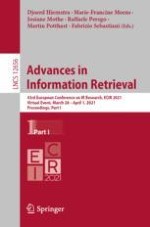This two-volume set LNCS 12656 and 12657 constitutes the refereed proceedings of the 43rd European Conference on IR Research, ECIR 2021, held virtually in March/April 2021, due to the COVID-19 pandemic.
The 50 full papers presented together with 11 reproducibility papers, 39 short papers, 15 demonstration papers, 12 CLEF lab descriptions papers, 5 doctoral consortium papers, 5 workshop abstracts, and 8 tutorials abstracts were carefully reviewed and selected from 436 submissions.
The accepted contributions cover the state of the art in IR: deep learning-based information retrieval techniques, use of entities and knowledge graphs, recommender systems, retrieval methods, information extraction, question answering, topic and prediction models, multimedia retrieval, and much more.
